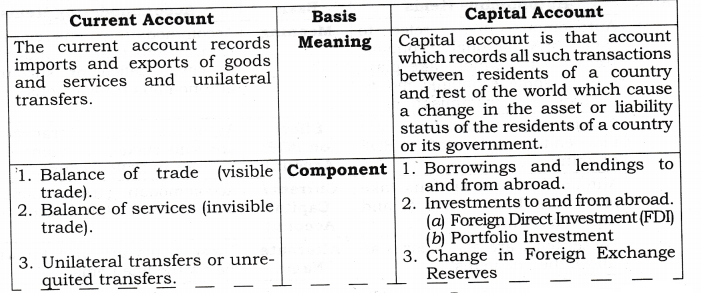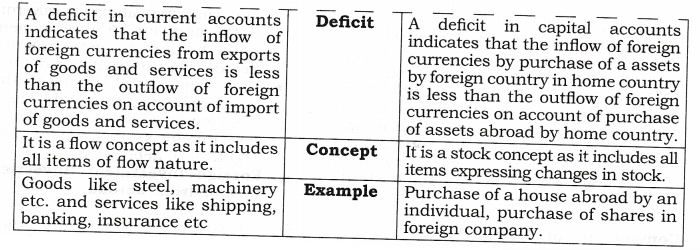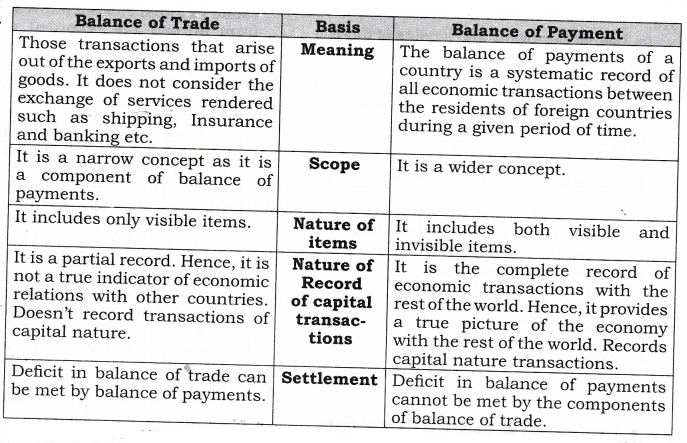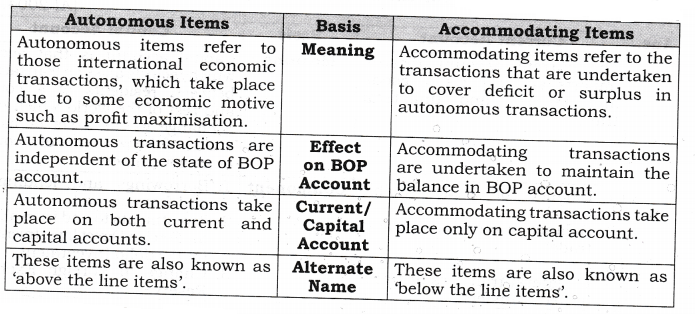NCERT Solutions for Class 12 Macro Economics Balance of Payment
NCERT TEXTBOOK QUESTIONS SOLVED
Question 1. Differentiate between Balance of Trade and Current Account Balance.
[3 Marks] Or
Distinguish between BOT and Balance on current account.[AI 2008, CBSE 2013, Sample Paper 2013]
Answer:


Question 2. Should a current account deficit be a cause for alarm? Explain.[1 Mark]
Answer: No, if deficit in current account is offset by the capital account, otherwise such deficit has to be met by following which is a cause for alarm.
- Depleting Foreign Exchange reserves
- Taking foreign Loans.
Value: Analytic.
Question 3. If inflation is higher in country A than in country B, and the exchange rate between the two countries is fixed. What is likely to happen to the trade balance between the two countries?[1 Mark]
Answer: The exports from country B to country A will go up in this situation resulting in improvement or surplus trade balance for B. But due to higher price in country A, its imports will increase for country B and it will lead to deficit in trade balance for country A.
MORE QUESTIONS SOLVED
I.Very Short Answer Type Questions (1 Mark)
Question 1. What does balance of payments account of a country record? [CBSE 2007]
Answer: Balance of payments is an accounting statement that provides a systematic record of all the economic transactions between the residents of a country and the rest of the world during a given period of time.
Question 2. What is meant by visible items?
Answer: Visible items include material goods [such as sugar, cloth, machines etc.] which can be seen or touched, counted, measured and weighted and which are duly recorded at the custom barriers.
Question 3. What is the meaning of invisible items?
Answer: Invisible items, on the other hand, refer to different kinds of services such as transport, banking, insurance etc.
Question 4. Why are imports entered as negative items in the balance of payments account?
Answer: Imports lead to an outflow of foreign exchange in the country. Thus, they are recorded as negative (debit) items.
Question 5. What is meant by balance of trade? [CBSE 2005, Sample Paper 2010]
Answer: The term “balance of trade” denotes the difference between the exports and imports of goods in a country.
Question 6. Name the items included in balance of trade account. [CBSE 2007]
Answer:
- Exports of visible items (goods);
- Imports of visible items (goods).
Question 7. When will balance of trade show a deficit? [CBSE 2006]
Answer: When imports of visible items are more than exports of visible items.
Question 8. How is a deficit or a surplus on the current account restored?
Answer: Deficit on the current account is restored through the surplus on capital account and surplus on the current account is restored through the deficit on capital account.
II.Multiple Choice Questions (1 Mark)
Question 1.——————–is a systematic record of all the economic transactions between one country and rest of the world.
(a) Balance of trade
(b) Balance of transactions
(c) Budget
(d) Balance of payments
Answer: (d)
Question 2. If India exports goods worth Rs 20 crore and imports goods worth Rs 30 crore, it will have a———————-.
(a) surplus of Rs 10 crore in balance of trade
(b) deficit of Rs 10 crore in balance of trade
(c) deficit of ? 50 crore in balance of trade
(d) can’t say
Answer: (b)
Question 3. Which one of the following items is an intangible item in balance of payments statement?
(a) Export of food grains
(b) Import of crude oil
(c) Banking services provided in other countries
(d) Import of steel by steel industry
Answer: (c)
Question 4. Which one of the following statements
deals with debts and claims of a country?
(a) Balance of capital account
(b) Balance of trade account
(c) Balance of current account
(d) Balance of services
Answer: (a)
Question 5. Name the economic transactions which are undertaken to make equilibrium in balance of payment,
(a) Autonomous items
(b) Accommodating items
(c) Invisible items
(d) None of them
Answer: (b)
Question 6. Current account of BOP records transactions is relating to——————.
(a) exchange of goods
(b) exchange of services
(c) unilateral transfers
(d) all of them
Answer: (d)
Question 7. Current transactions are of————-.nature.
(a) flow
(b) stock
(c) both flow and stock
(d) none of the above
Answer: (a)
Question 8. Capital account may be ————–.
(a) private capital
(b) banking capital
(c) official capital
(d) all of them
Answer: (d)
III.Short Answer Type Questions (3-4 Marks)
Question 1. State four items of current account of BOP account.[CBSE 2004, 08, 08C, 09; AI 05]
Or
Name the broad categories of transactions recorded in the Current account of the balance of payment accounts. [CBSE 2015]
Answer: Current account records imports and exports of goods and services and unilateral transfers.
Components of Current Account The main components of Current Account are:
- Export and Import of Goods (Merchandise Transactions or Visible Trade): A major part of transactions in foreign trade is in the form of export and import of goods (visible items). Payment for import of goods is written on the negative side (debit items) and receipt from exports is shown on the positive side (credit items). Balance of these visible exports and imports is known as balance of trade (or trade balance).
- Export and Import of Services (Invisible Trade): It includes a large variety of non-factor services (known as invisible items) sold and purchased by the residents of a country, to and from the rest of the world. Payments are either received or made to the other countries for use of these services. Services are generally of three kinds: (a) Shipping,
(b) Banking, and (c) Insurance. Payments for these services are recorded on the negative side and receipts on the positive side. - Unilateral or Unrequisted Transfers to and from abroad (One sided Transactions): Unilateral transfers include gifts, donations, personal remittances and other ‘one-way’ transactions. These refer to those receipts and payments, which take place without any service in return. Receipt of unilateral transfers from rest of the world is shown on the credit side and unilateral transfers to rest of the world on the debit side.
- Income receipts and payments to and from abroad: It includes investment income in the form of interest, rent and profits.
Question 2. What do you mean by capital account and what are its components?
Or
State four items (components) of capital account of BOP account.[CBSE 2004, 11, AI 05]
Or
Name the broad categories of transactions recorded in the Capital account of the balance of payment accounts. [CBSE 2015]
Answer: Capital account is that account which records all such transactions between residents of a country and rest of the world which cause a change in the asset or liability status of the residents of a country or its government.
Components of Capital Account
The main components of capital account are:
- Loans: Borrowing and lending of funds are divided into two transactions:
(a) Private Transactions
• These are transactions that are affecting assets or liabilities by individuals, businesses, etc. and other non-government entities. The bulk of foreign investment is private.
• For example, all transactions relating to borrowings from abroad by private sector and similarly repayment of loans by foreigners are recorded on the positive (credit) side.
• All transactions of lending to abroad by private sector and similarly repayment of loans to abroad by private sector is recorded as negative or debit item.
(b) Official Transactions
• Transactions affecting assets and liabilities by the government and its agencies.
• For example, all transactions relating to
borrowings from abroad by government sector and similarly repayment of loans by foreign government are recorded on the positive (credit) side.
• All transactions of lending to abroad by government sector and similarly repayment of loans to abroad by government sector is recorded as negative or debit item. - Foreign Investment (Investments to and from abroad) It includes:
(a) Investments by rest of the world in shares of Indian companies, real estate in India, etc. Such investments from abroad are recorded on the positive (credit) side as they bring in foreign exchange.
(b) Investments by Indian residents in shares of foreign companies, real estate abroad, etc. Such investments to abroad are recorded on the negative (debit) side as they lead to outflow of foreign exchange. - Change in Foreign Exchange Reserves
(a) The foreign exchange reserves are. the financial assets of the government held in central bank. A change in reserves serves as the financing item in India’s BOP.
(b) So, any withdrawal from the reserves is recorded on the positive (credit) side and any addition to these reserves is recorded on the negative (debit) side.
(c) It must be noted that ‘change in reserves’ is recorded in the BOP account and not ‘reserves’.
Question 3. Distinguish between current account and capital account of BOP account.[AI 2004, 06 C]
Answer:


Question 4. Distinguish between balance of trade and balance of payment. [AI 2004, 06C]
Answer:

Question 5. Distinguish between autonomous and accommodating transactions of BOP account. ” [AI 2010; CBSE 10, 13C]
Answer:

Question 6. Where is ‘borrowings from abroad’ recorded in the Balance of Payments Accounts? Give reasons. [AT 2015]
Answer:
- Borrowing from abroad is a part of Capital Account.
- Borrowing from abroad can be private transactions or official transactions.
- For example,
(a) All transactions relating to borrowings from abroad by private sector are recorded on the positive (credit) side as it is inflow of foreign currency.
(b) Similarly, transactions relating to borrowings from abroad by government sector are recorded on the positive (credit) side as it is inflow of foreign currency.
Question 7. Where will sale of machinery to abroad be recorded in the balance of payment accounts? Give reasons. [CBSE 2015]
Answer:
- Sale of machinery to abroad is a part of Current accounts.
- Current account records imports and exports of goods and services and unilateral transfers.
- Sale of machinery to abroad leads to inflow of foreign currency and receipt from exports is shown on the positive side (credit items).
Question 8. What is meant by ‘official reserve transactions’? Discuss their importance in Balance of Payments.[CBSE Sample Paper 2016]
Answer:
- Official reserve transactions are those transactions by a central bank that cause changes in its official reserves.
- It is sale or purchase of its own currency in the exchange market in exchange for foreign currencies.
- So, any withdrawal from the reserves is recorded on the positive (Credit) side and any addition to these reserves is recorded on the negative (debit) side.
- They may be Autonomous and Accommodating Transactions.
IV. True Or False
Giving reasons, state whether the following statements are true or false.
Question 1. In balance of payments, repayment of loans by Indian Government to American Government will be reflected as debit item.
Answer: True. It is so because it leads to outflow of foreign exchange.
Question 2. Accommodating items of trade are undertaken in order to maintain the balance in the BOP account.
Answer: True. Accommodating transactions are net consequences of autonomous transactions that are undertaken to correct disequilibrium in autonomous items of BOP.
Question 3. Excess of foreign exchange payments on account of accommodating transactions equals deficit in BOP.[CBSE 2011 ]
Answer: False. Excess of foreign exchange payments on account of autonomous transactions equals deficit in BOP.
Question 4. Export and import of machines are recorded in capital account of BOP account. [CBSE 2011 ]
Answer: False. Export and import of machines are considered as export and import of goods, that comes under current account of BOP account.
Question 5. Foreign exchange received on account of export of sugar will be X’ecorded in current account.
Answer: True. It is so because export of sugar is a export of goods which is a component of current account.
Question 6. Accommodating items are also known as ‘above the line’ items.
Answer: False. Accommodating items are also known as ‘below the line’ items. (Autonomous items are also known as ‘above the line’ items.)
Question 7. Unilateral transfers received from abroad will be recorded as a credit item of BOP on current account.
Answer: True. It leads to inflow of foreign exchange.
Question 8. Borrowing by government from World Bank to finance the BOP deficit will be recorded in the capital account.
Answer: True. Borrowing by the government is a accommodating transaction and it is recorded in the capital account only.
Question 9. Autonomous transactions take place in current account only.
Answer. False. Autonomous transactions take place in both current and capital accounts.
Note: As per CBSE guidelines, no marks will be given if reason to the answer is not explained.
V. Higher Order Thinking Skills
Question 1. What does deficit in a current account indicate? [1 Mark]
Answer: A deficit in a current account indicates that the inflow of foreign currencies from exports of goods and services is less than the outflow of foreign currencies on account of import of goods and services.
Question 2. What does deficit in capital accounts indicate? [ 1 Mark]
Answer: A deficit in capital accounts indicates that the inflow of foreign currencies by purchase of an assets by a foreign country in home country is less than the outflow of foreign currencies on account of purchase of assets abroad by home country.
Question 3. Explain the meaning of deficit in BOP. [CBSE 2010, AI 13] [3-4 Marks]
Answer:
- The balance of payments of a country is a systematic record of all economic transactions between the residents of foreign countries during a given period of time.
- The transaction in the balance of payment account can be categorized as autonomous transactions and accommodating transactions.
- Autonomous transactions are transactions done for some economic consideration such as profit.
- When the total inflows on account of autonomous transactions are less than total outflows on account of such transactions, there is a deficit in the balance of payments account.
- Suppose, the autonomous inflow of foreign exchange during the year is $500, while the total outflow is $600. It means that there is a deficit of $100.
Question 4. The balance of trade shows a deficit of Rs 5,000 crore and the value of imports are Rs 9,000 crore. What is the value of exports? [CBSE 2004] [3 Marks]
Answer: Balance of Trade = -Rs 5,000 crore Value of Imports = Rs 9,000 crore Balance of trade (Deficit) = Value of Exports – Imports Value of Exports = Balance of trade (Deficit) + Imports = -Rs 5,000 crore + Rs 9,000 crore = Rs 4,000 crore
Question 5. The balance of trade shows a deficit of Rs 300 crore. The value of exports is Rs 500 crore. What is the value of imports? [CBSE 2004][3 Marks]
Answer: Balance of Trade = -Rs 300 crore Value of exports = Rs 500 crore Balance of trade (Deficit) = Value of Exports – Imports
Imports = Exports – Balance of trade ((deficit)
= Rs 500 crore – (-Rs 300 crore)= Rs 800 crore
VI. Application Based Questions
Question 1. How can increase in foreign direct investment affect the price of foreign exchange? [CBSE 2013 (Set I)][l Mark]
Answer: Increase in foreign direct investment can affect the price of foreign exchange because increase in foreign direct investment raises the supply of foreign exchange that lowers the price of foreign exchange.
Question 2. State whether the following transactions will be recorded on debit or credit side of BOP. [3-4 Marks]
- Loan from IMF to cover deficit of BOP.
- Indian Government repays loan taken from IMF.
- Purchase of shares of Infosys by a Japanese resident.
- Export of Jute to Sri Lanka.
- Acquisition of a foreign company by Tata.
- Purchase of toys from China.
Answer: Transactions relating to inflow of foreign exchange will be recorded on the credit side and outflows of foreign exchange on the debit side. Debit Side: (2), (5), (6); and Credit Side: (1), (3), (4).
Question 3. Identify the following items as visible items or invisible items. [3-4 Marks}
- Export of computer software
- Import of LCD screen from Malaysia
- Banking service to NRI
- Export of Tea to Thailand
- Consultancy services of TCS used by a foreign firm
Answer: Visible Items: (2), (4); Invisible Items: (1), (3), (5).
Question 4. Classify whether the following transactions will be recorded in current account or capital account. [3-4 Marks]
- Purchase of shares of Tata by Microsoft.
- Imports of computer spare parts from America.
- Borrowings from World Bank.
- Repayment of loan by Indian Government taken from Japan.
- Gifts received from a relative in Australia.
- Purchase of Land in China.
- Import of machinery.
Answer: Current Account: (2), (5), (7); Capital Account: (1), (3), (4), (6).
